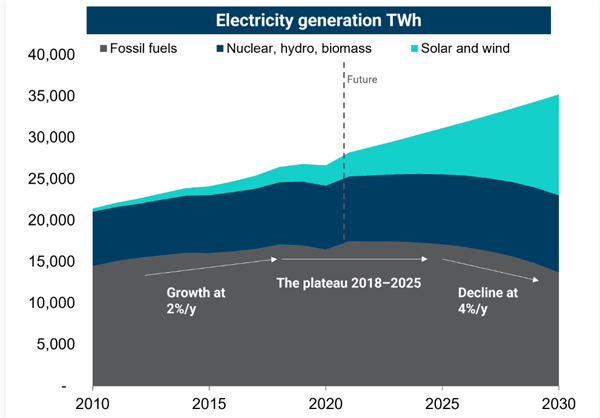
Priscila Azevedo Rocha, Bloomberg News
LONDON
EnergiesNet.com 07 14 2023
The exponential growth of renewable energy is pushing down global electricity prices and helping remove so much carbon from power systems that fossil fuels are no longer economical, and their use has peaked, according to a report.
From China to Europe, the capacities of solar, battery and wind power are surging, the Rocky Mountain Institute said in an analysis released Thursday in conjunction with the Bezos Earth Fund. That means sending demand for gas, oil and coal linked to electricity generation into a steep decline, a critical step toward curbing emissions linked to climate change.
“Fossil-fuel demand in the electricity system, specifically, has clearly peaked in 2022,” Kingsmill Bond, senior principal at RMI, told reporters. Moving forward, it’s “very hard actually for fossil-fuel demand to grow from these levels simply because of the speed of which these alternative technologies grow.”
The shift comes as governments and industries rebuild their energy infrastructure following supply shortages and skyrocketing prices in the wake of Russia’s invasion of Ukraine. The high rates of deployment also are driving down prices for renewables, rendering higher cost hydrocarbons uncompetitive.
Solar Beats Coal in Europe for First Time – But There’s a Glitch
Solar panels and wind turbines will supply more than a third of global electricity by 2030, compared with about 12% today, the RMI forecasts. Those sources should produce as much as 14,000 terawatt-hours, overtaking fossil fuels.
While China and Europe lead the growth in clean energy, deployment is reaching other parts of the globe. Namibia, the Netherlands, Palestine, Jordan and Chile have boosted solar and wind generation at sufficient rates for five years, according to a separate report released at the same time.
Renewables are already considered a cheaper form of electricity, with costs plummeting during the past decade, according to BloombergNEF. Solar and battery costs declined 80% between 2012 and 2022, offshore wind dropped 73% and onshore wind fell 57%, the data show.
The increasing adaptation of clean-tech is set to halve its prices by 2030 — falling to as low as $20 a megawatt-hour for solar from $40-plus now, RMI said. The shift in capital out of fossil fuels is also set to boost investment in low-carbon forms of energy.
“Change is happening faster than we think,” Christiana Figueres, an architect of the Paris Agreement on climate, said during a roundtable discussion. “The tripling of renewables by 2030 is not guaranteed but is more possible today than it ever was because of the exponential trends that we are seeing.”
bloomberg.com 07 12 2023












